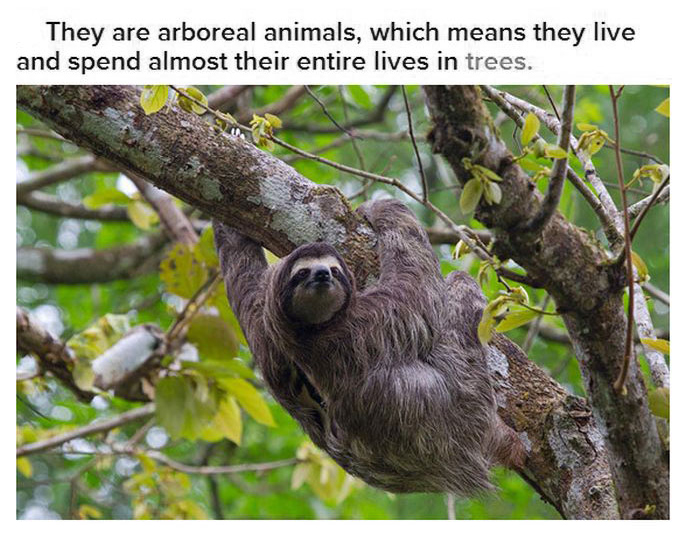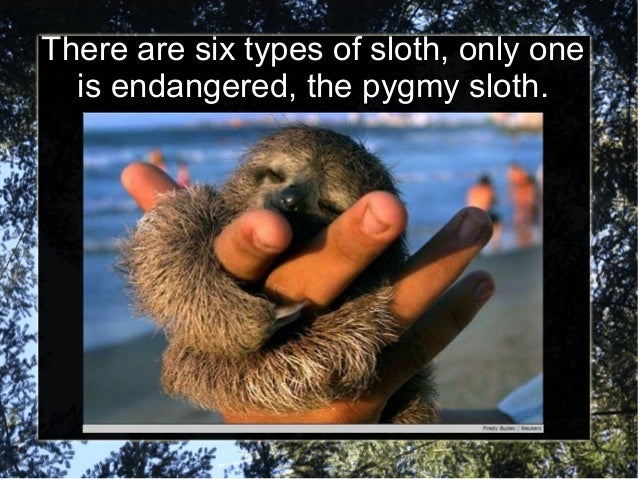

Sloths are in the taxonomic suborder Folivora of the order Pilosa. The earliest xenarthrans were arboreal herbivores with sturdy vertebral columns, fused pelvises, stubby teeth, and small brains. Anteaters and armadillos are also included among Xenarthra. One study found that xenarthrans broke off from other placental mammals around 100 million years ago. Sloths belong to the superorder Xenarthra, a group of placental mammals believed to have evolved in the continent of South America around 60 million years ago. The algae also nourish sloth moths, some species of which exist solely on sloths. The shaggy coat has grooved hair that is host to symbiotic green algae which camouflage the animal in the trees and provide it nutrients. Sloths are almost helpless on the ground, but are able to swim. Their slowness permits their low-energy diet of leaves and avoids detection by predatory hawks and cats that hunt by sight. French: paresseux, Spanish: perezoso) also mean "lazy" or similar. Sloth, related to slow, literally means "laziness," and their common names in several other languages (e.g. Sloths are so named because of their very low metabolism and deliberate movements. Members of an endemic radiation of Caribbean sloths also formerly lived in the Greater Antilles but became extinct after humans settled the archipelago in the mid-Holocene, around 6,000 years ago. The extinction correlates in time with the arrival of humans, but climate change has also been suggested to have contributed. However, they became extinct during the Quaternary extinction event around 12,000 years ago, along with most large bodied animals in the New World. Besides the extant species, many species of ground sloths ranging up to the size of elephants (like Megatherium) inhabited both North and South America during the Pleistocene Epoch. The two groups of sloths are from different, distantly related families, and are thought to have evolved their morphology via parallel evolution from terrestrial ancestors. Despite this traditional naming, all sloths have three toes on each rear limb- although two-toed sloths have only two digits on each forelimb. There are six extant sloth species in two genera – Bradypus (three–toed sloths) and Choloepus (two–toed sloths). Sloths are considered to be most closely related to anteaters, together making up the xenarthran order Pilosa. Noted for their slowness of movement, tree sloths spend most of their lives hanging upside down in the trees of the tropical rainforests of South America and Central America. Sloths are a group of Neotropical xenarthran mammals constituting the suborder Folivora, including the extant arboreal tree sloths and extinct terrestrial ground sloths. It’s estimated that the extinct ancestors of sloths were the size of an elephant, like the Megatherium.Temporal range: Early Oligocene to Holoceneĭelsuc, Catzeflis, Stanhope, and Douzery, 2001.The four living three-toed sloth species are the Brown-throated three-toed sloth (Bradypus variegatus), the Maned three-toed sloth (Bradypus torquatus), the Pale-throated three-toed sloth (Bradypus tridactylus) and the Pygmy three-toed sloth (Bradypus pygmaeus).

The two living two-toed sloth species are the Linnaeus’s two-toed sloth (Choloepus didactylus) and the Hoffmann’s two-toed sloth (Choloepus hoffmanni).There are four living species of three-toed sloths and they belong to the Bradypodidae family and the Bradypus genus.There are two living species of two-toed sloths and they belong to the Choloepodidae family and the Choloepus genus.The six living species of sloths are divided into two groups, the two-toed sloths and the three-toed sloths.There is a total of six living species of sloths between two different families.Sloths depend on their sense of touch and smell to locate food. Sloths can see in color and have the ability hear, but their visual and hearing acuity are poor.A sloth can live on average between 10 and 16 years.The average length of a sloth is between 24 and 31 inches but can vary by species.The average weight of a sloth is between 7.9 and 17 pounds but can vary by species.The three-toed sloth species are herbivores and feed exclusively on the leaves of only a few trees.The two-toed sloth species are omnivores and have a diet of fruits, leaves, insects and some small reptiles.Sloths can be found in the rainforests of Central and South America.


 0 kommentar(er)
0 kommentar(er)
